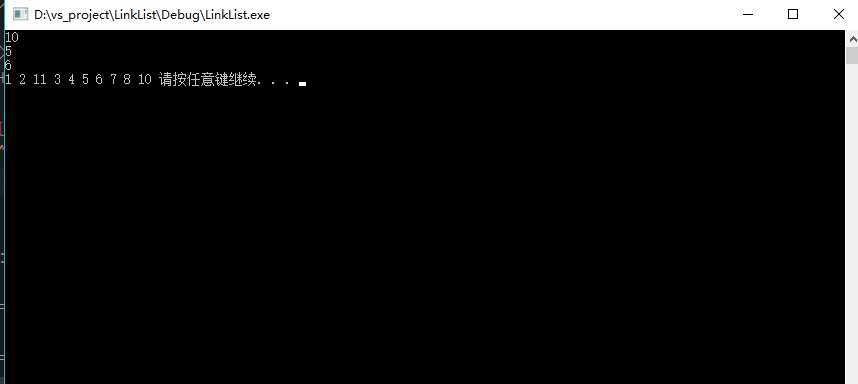将线性表的抽象数据类型定义在链接存储结构下用C++的类实现,由于线性表的数据元素类型不确定,所以采用模板机制。
1 头文件linklist.h 2 #pragma once 3 #include <iostream> 4 // 单链表的节点 5 template<class T> 6 struct Node 7 { 8 T data;//数据域 9 Node<T> *next;// 指针域,指向后继节点 10 }; 11 // 单链表的类实现 12 template<class T> 13 class LinkList 14 { 15 public: 16 LinkList();// 无参构造函数,建立只有头节点的空链表 17 LinkList(T a[],int n);// 有参构造函数,建立有n个元素的单链表 18 ~LinkList();// 析构函数 19 int Length();// 求单链表的长度 20 T Get(int i);// 查找第i个元素 21 int Locate(T x);// 查找值为x的元素 22 void Insert(int i, T x);// 在第i个元素处插入x 23 T Delete(int i);// 删除第i个节点 24 void PrintList();// 遍历各个元素 25 private: 26 Node<T>* first;// 单链表的头节点 27 }; 28 29 template<class T> 30 inline LinkList<T>::LinkList() 31 { 32 first = new Node<T>; // 生成头节点 33 first->next = NULL; // 头节点指针域为空 34 } 35 36 // 头插法建立单链表 37 template<class T> 38 LinkList<T>::LinkList(T a[], int n) 39 { 40 first = new Node<T>; 41 first->next = NULL; // 初始化一个空链表 42 for (int i = 0; i < n; i++) 43 { 44 Node<T>* S = new Node<T>; 45 S->data = a[i]; // 为每个数据元素建立一个节点 46 S->next = first->next; 47 first->next = S; // 将节点S插入头节点之后 48 } 49 } 50 // 尾插法建立单链表 51 template<class T> 52 LinkList<T>::LinkList(T a[], int n) 53 { 54 first = new Node<T>;// 建立头节点 55 first->next = NULL; 56 Node<T>* r = first;// 尾指针初始化 57 for(int i = 0; i < n; i++) 58 { 59 Node<T>* S = new Node<T>; 60 S->data = a[i]; // 为每个数据元素建立一个节点 61 r->next = S; 62 r = S; // 插入节点S,并将尾指针指向S节点 63 } 64 r->next = NULL; // 单链表建立完毕之后,将尾指针置空 65 } 66 67 template<class T> 68 LinkList<T>::~LinkList() 69 { 70 while (first != NULL) 71 { 72 Node<T>* p = first; // 暂存将被释放节点 73 first = first->next; // 指向下一个节点 74 delete p; 75 } 76 } 77 78 template<class T> 79 int LinkList<T>::Length() 80 { 81 int count = 0; // 计数 82 Node<T>* p = first->next; // 将工作指针指向第一个节点 83 while (p != NULL) 84 { 85 count++; 86 p = p->next; 87 } 88 return count; 89 } 90 91 template<class T> 92 T LinkList<T>::Get(int i) 93 { 94 int count = 0; // 计数 95 Node<T>* p = first->next; // 将工作指针指向第一个节点 96 while (p != NULL) 97 { 98 count++; 99 if (count == i) 100 return p->data; 101 p = p->next; 102 } 103 return -1; // 越界 104 } 105 106 template<class T> 107 int LinkList<T>::Locate(T x) 108 { 109 int count = 0; // 计数 110 Node<T>* p = first->next; // 将工作指针指向第一个节点 111 while (p != NULL) 112 { 113 count++; 114 if (p->data == x) 115 return count; 116 p = p->next; 117 } 118 return 0; // 查找失败 119 } 120 121 template<class T> 122 void LinkList<T>::Insert(int i, T x) 123 { 124 int count = 0; // 计数 125 Node<T>* p = first; // 将工作指针指向头节点 126 while (p != NULL) 127 { 128 if (count == i - 1) // 找第i-1个节点 129 { 130 Node<T>* S = new Node<T>; 131 S->data = x; 132 S->next = p->next; 133 p->next = S; 134 } 135 p = p->next; 136 count++; 137 } 138 if (p == NULL) 139 throw "位置越界"; 140 } 141 142 template<class T> 143 T LinkList<T>::Delete(int i) 144 { 145 int count = 0; // 计数 146 Node<T>* p = first; // 将工作指针指向头节点 147 while (p != NULL) 148 { 149 if (count == i - 1) 150 { 151 Node<T>* q = p->next;// 暂存被删节点 152 T x = q->data; 153 p->next = q->next; 154 delete q; 155 return x; 156 } 157 p = p->next; 158 count++; 159 } 160 return -1; 161 } 162 163 template<class T> 164 void LinkList<T>::PrintList() 165 { 166 Node<T>* p = first->next; // 将工作指针指向第一个节点 167 while (p != NULL) 168 { 169 cout << p->data << " "; 170 p = p->next; 171 } 172 }
主函数 #include"linklist.h" using namespace std; int main() { int arry[10] = { 1, 2, 3, 4, 5, 6, 7, 8, 9, 10 }; LinkList<int>* linklist = new LinkList<int>(arry, 10); cout << linklist->Length() << endl; cout << linklist->Get(5) << endl; cout << linklist->Locate(6) << endl; linklist->Insert(3, 11); linklist->Delete(10); linklist->PrintList(); system("pause"); return 0; }
运行结果如下:

